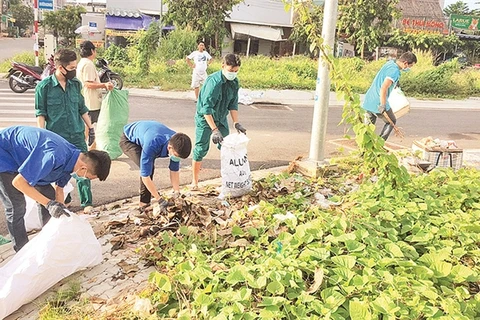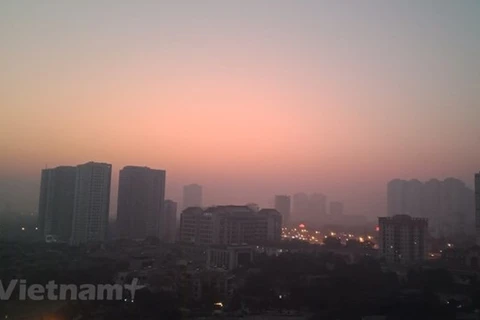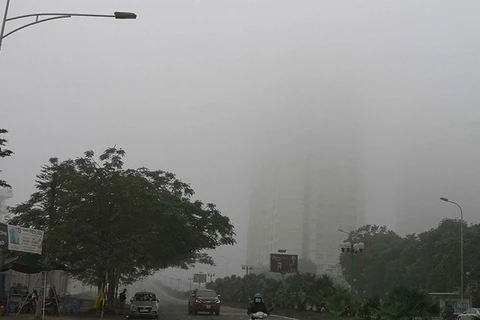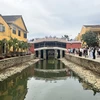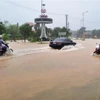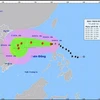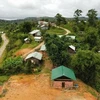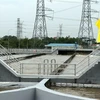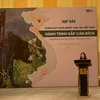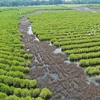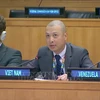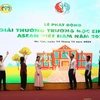Hanoi (VNS/VNA) - Air quality in the capital city of Hanoi fell to dangerous levels in the first week of the New Year, particularly in inner city areas, according to the Department of Natural Resources and Environment.
The air quality index (AQI) figures have been reported to the municipal People's Committee who are working with relevant agencies to identify the causes of the pollution and for measures to improve air quality.
Results from 35 air quality monitoring stations in the city showed that the AQI tended to increase from January 1, and rose sharply up on the morning of January 5, hit the peak warning level of 5/6.
From December 29 to December 31, 2020, most of the stations showed that the AQI was good or medium level.
However, from January 1, 2021, the air quality tended to drop sharply, some locations including the Environmental Protection Department, the People's Committee of Minh Khai Ward, and the French Embassy.
According to the city's Department of Natural Resources and Environment, this is due to the intensification of the northeast monsoon, influence of cold air with strong winds which promoted a diffusion of pollutants, so the air quality was kept at good and medium levels in period from December 29 to 31, 2020.
However, when the cold air decreased with low wind speeds and the temperature dropped at night, dense fog formed, hindering the diffusion of pollution, causing pollution.
Additionally, the pollutants caused by traffic, construction and industrial production in the inner city, and neighbouring provinces accumulated.
The increases of traffic activities after the New Year holiday, of garbage stagnation, spontaneous burning of waste causing environmental pollution, year-end production to supply goods during the Lunar New Year, were also listed as causes of pollution emissions.
Warning heavily polluted days in winter
The National Centre for Meteorological and Hydrological Forecasting predicted that from January to March, 2021, many adverse meteorological weather situations will appear, causing deterioration of air quality and affecting people's health.
The city has erected 35 air quality monitoring stations, providing information on air environment indicators for people to prevent and take measures to protect their health.
At the same time, the city has effectively deployed directives, plans and programmes such as a ban on traditional charcoal stoves and burning of straw and crop residues after harvest.
Environmental experts suggest people limit the opening of windows and doors at times of bad air quality, especially families near roads and polluted areas while planting trees in and around the house helps to prevent dust and clean the air.
In the days of very-bad weather, people are advised not to go out to exercise in the morning and evening, the most polluted time of the day, especially the elderly and children and schools should not organise outdoor activities.
Health experts advise people in bad weather to clean their respiratory tract with normal saline, especially when going to the street and wash their eyes with saline before going to bed./.
The air quality index (AQI) figures have been reported to the municipal People's Committee who are working with relevant agencies to identify the causes of the pollution and for measures to improve air quality.
Results from 35 air quality monitoring stations in the city showed that the AQI tended to increase from January 1, and rose sharply up on the morning of January 5, hit the peak warning level of 5/6.
From December 29 to December 31, 2020, most of the stations showed that the AQI was good or medium level.
However, from January 1, 2021, the air quality tended to drop sharply, some locations including the Environmental Protection Department, the People's Committee of Minh Khai Ward, and the French Embassy.
According to the city's Department of Natural Resources and Environment, this is due to the intensification of the northeast monsoon, influence of cold air with strong winds which promoted a diffusion of pollutants, so the air quality was kept at good and medium levels in period from December 29 to 31, 2020.
However, when the cold air decreased with low wind speeds and the temperature dropped at night, dense fog formed, hindering the diffusion of pollution, causing pollution.
Additionally, the pollutants caused by traffic, construction and industrial production in the inner city, and neighbouring provinces accumulated.
The increases of traffic activities after the New Year holiday, of garbage stagnation, spontaneous burning of waste causing environmental pollution, year-end production to supply goods during the Lunar New Year, were also listed as causes of pollution emissions.
Warning heavily polluted days in winter
The National Centre for Meteorological and Hydrological Forecasting predicted that from January to March, 2021, many adverse meteorological weather situations will appear, causing deterioration of air quality and affecting people's health.
The city has erected 35 air quality monitoring stations, providing information on air environment indicators for people to prevent and take measures to protect their health.
At the same time, the city has effectively deployed directives, plans and programmes such as a ban on traditional charcoal stoves and burning of straw and crop residues after harvest.
Environmental experts suggest people limit the opening of windows and doors at times of bad air quality, especially families near roads and polluted areas while planting trees in and around the house helps to prevent dust and clean the air.
In the days of very-bad weather, people are advised not to go out to exercise in the morning and evening, the most polluted time of the day, especially the elderly and children and schools should not organise outdoor activities.
Health experts advise people in bad weather to clean their respiratory tract with normal saline, especially when going to the street and wash their eyes with saline before going to bed./.
VNA

